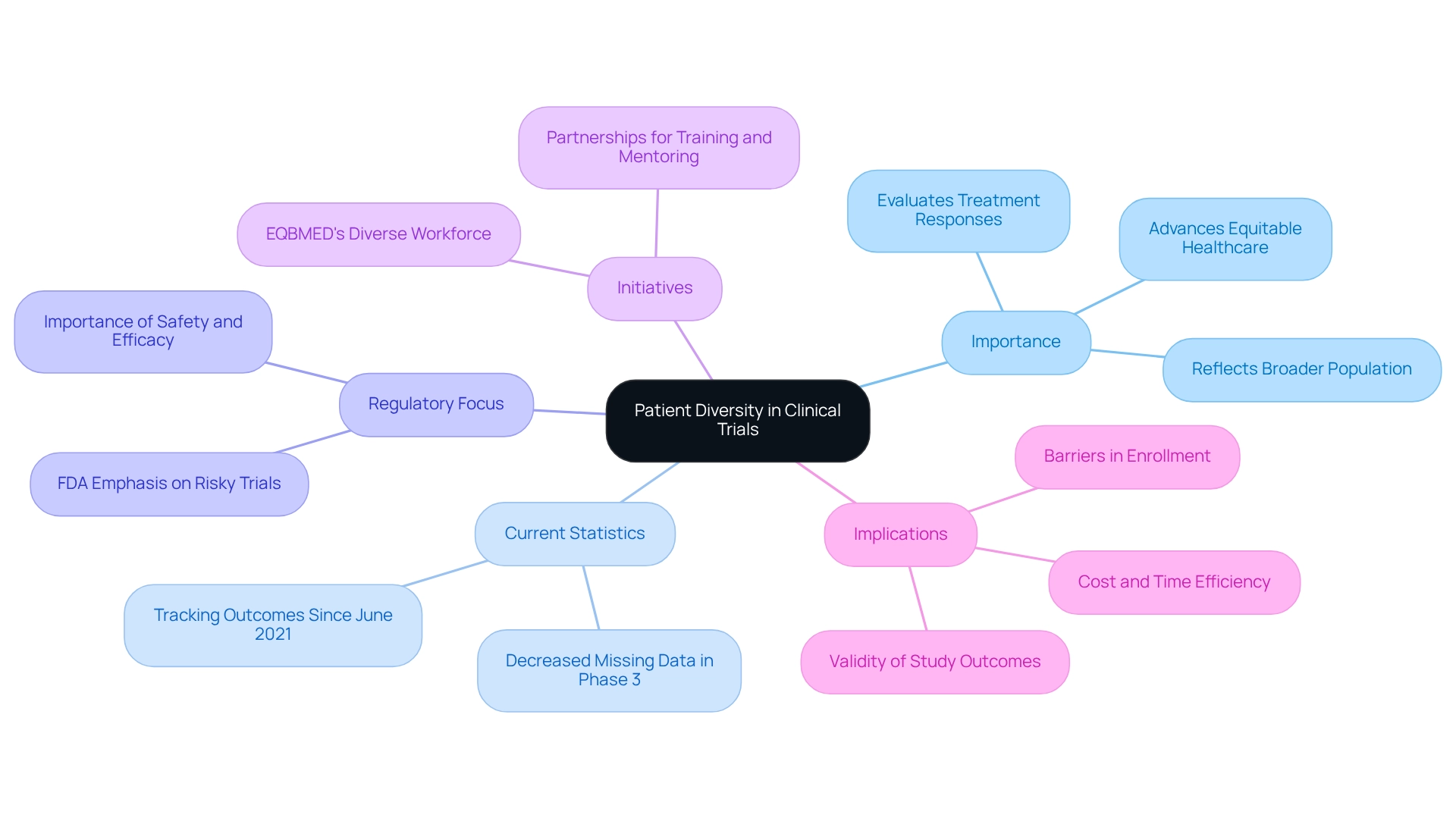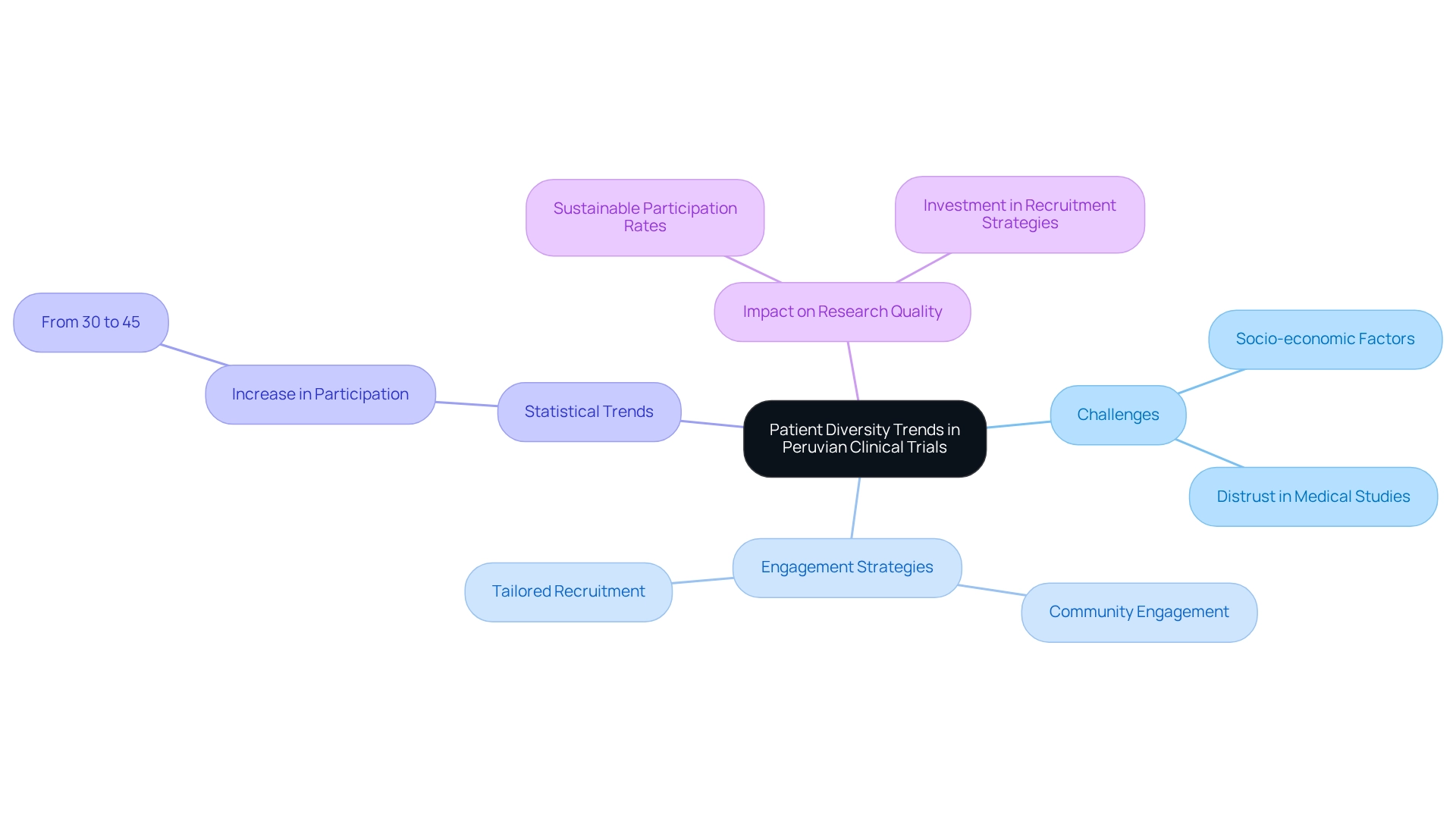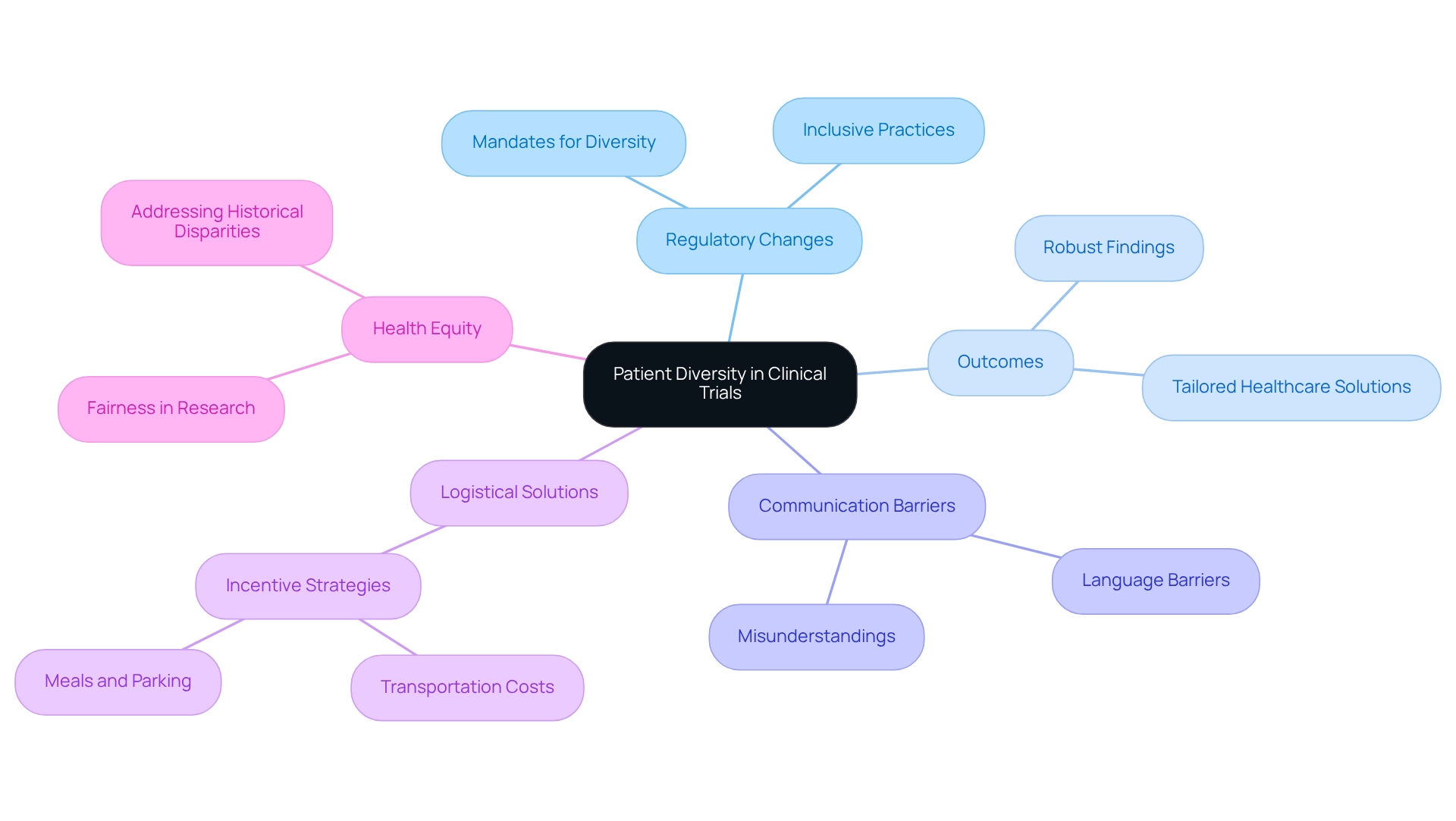Overview
The article addresses the trends and implications of patient diversity in Peruvian clinical trials, underscoring its critical importance for ensuring that research outcomes reflect the broader population. Increasing diversity not only leads to more valid and applicable findings but also enhances health equity, as evidenced by statistics that reveal rising participation rates and initiatives designed to overcome barriers to enrollment among underrepresented groups. This focus on diversity is essential for advancing clinical research and improving overall health outcomes.
Introduction
As the landscape of clinical research evolves, the importance of patient diversity has emerged as a pivotal factor in ensuring that medical trials yield results applicable to a broad spectrum of populations. From varying races and ethnicities to diverse socio-economic backgrounds, the inclusion of a heterogeneous participant pool is essential for accurately assessing treatment efficacy and safety.
This article delves into the multifaceted dimensions of patient diversity in clinical trials, highlighting current trends, particularly in Peru, and examining global initiatives that aim to enhance representation. By exploring the implications of these trends, it becomes clear that fostering diversity is not only a matter of regulatory compliance but a fundamental necessity for advancing equitable healthcare outcomes that resonate across all communities.
Defining Patient Diversity in Clinical Trials
Participant variation in research studies is crucial, highlighting the importance of patient diversity in Peruvian clinical trials by incorporating individuals from a wide array of demographic backgrounds, including different races, ethnicities, genders, ages, and socio-economic statuses. The patient diversity in Peruvian clinical trials is essential for ensuring that research outcomes accurately reflect the broader population.
Patient diversity in Peruvian clinical trials allows researchers to evaluate how different groups respond to treatments, which can vary significantly due to genetic, environmental, and cultural influences. Without this variety, research can yield biased results that fail to represent the effectiveness and safety of medical treatments across diverse populations. Therefore, defining patient diversity in Peruvian clinical trials is vital for advancing equitable healthcare results and enhancing the applicability of clinical findings.
Current statistics reveal that as of 2021, Phase 3 studies have shown a decreased percentage of participants lacking race or ethnicity information compared to all NIH studies, highlighting a positive trend towards improved data collection in clinical investigations. Furthermore, the FDA has underscored the regulatory focus on studies that may pose greater risks to human subjects, emphasizing the necessity of patient diversity in Peruvian clinical trials to ensure safety and efficacy across populations.
Initiatives such as those from EQBMED stress the importance of fostering a diverse workforce to address the health challenges faced by underrepresented communities. By collaborating with organizations committed to education and guidance, they aim to enhance patient diversity in Peruvian clinical trials by increasing the representation of communities of color in medical studies, ultimately promoting health equity.
Expert insights reveal that the absence of diversity not only compromises the validity of medical study outcomes but also results in slower and more costly processes. For instance, studies on barriers in Alzheimer’s disease investigations indicate that enrollment difficulties lead to prolonged and expensive research timelines. Thus, the inclusion of varied participants is essential for patient diversity in Peruvian clinical trials, as it is not merely a regulatory requirement but a critical component of advancing medical studies that benefits all segments of society.
Moreover, the ongoing monitoring of outcomes across all experiments and Phase 3 studies as of June 2021 further reinforces the continuous efforts to enhance diversity in medical investigations.

Patient Diversity Trends in Peruvian Clinical Trials
In recent years, Peru has increasingly prioritized patient diversity in Peruvian clinical trials, recognizing its essential role in the validity and applicability of findings. The nation's demographic landscape, characterized by a diverse mix of native populations and urban communities, presents both unique opportunities and significant challenges for medical researchers. Despite a growing awareness of the necessity for diverse representation, substantial barriers persist. Socio-economic factors, coupled with a historical distrust of medical studies in certain communities, hinder participation rates.
To combat these challenges, innovative strategies are being employed. Community engagement efforts are at the forefront, with local organizations actively working to build trust and inform potential participants about the advantages of research studies. These initiatives are crucial for enhancing enrollment rates among underrepresented groups. For instance, tailored recruitment strategies that resonate with specific communities have shown promise in bridging the gap between research and diverse populations.
Recent trends indicate a shift towards more inclusive practices in medical studies, emphasizing the significance of patient diversity in Peruvian clinical trials. By 2025, statistics reveal a gradual increase in the participation of diverse patient groups, with reports showing a rise from 30% to 45% in the enrollment of underrepresented populations over the past year. Additionally, comprehensive medical study management services, such as those provided by bioaccess, significantly contribute to this progress. By facilitating feasibility studies, site selection, compliance reviews, experiment setup, project management, and reporting, bioaccess enhances the capacity of research projects to effectively engage diverse populations.
Case studies illustrate that while initial costs associated with recruiting diverse populations may be higher, as noted in the case study "Financial Considerations in Diverse Trial Recruitment," these costs tend to stabilize over time, leading to sustainable participation rates. This investment in efficient recruitment not only enhances the quality of medical studies but also fosters a more equitable healthcare environment. As emphasized by the FDA, "This continual investment, in the form of collecting formalized post-trial feedback, conducting community awareness and health literacy events, and providing continuing education and training programs for investigators and site staff, will form the foundation of an ongoing dialogue between communities and the industry.

Global Trends in Patient Diversity in Clinical Trials
The global landscape is increasingly recognizing the critical need for patient diversity in Peruvian clinical trials, which is driven by heightened awareness of health disparities and the demand for inclusive investigations. Regulatory bodies worldwide are establishing guidelines to ensure that clinical studies reflect patient diversity in Peruvian clinical trials. In the United States, the FDA has underscored the significance of variety in study design, urging sponsors to implement strategies that enhance participant representation. Notably, initiatives such as the All of Us Research Program aim to gather health data from diverse demographics to more effectively address health disparities.
Despite these advancements, challenges persist, particularly in recruiting diverse participants and ensuring culturally competent research practices. For instance, a study indicated that when educational strategies and travel cost compensation were introduced, participation among Black patients surged by over 100 percent. This finding underscores the importance of tailored approaches in enhancing patient diversity in Peruvian clinical trials—an insight that can be applied to research studies in Latin America, where similar strategies could lead to substantial improvements in participant representation.
bioaccess® offers comprehensive research study management services, including feasibility assessments, site selection, compliance evaluations, study setup, import permits, project management, and reporting. Their expertise in conducting Early-Feasibility Studies (EFS), First-In-Human Studies (FIH), Pilot Studies, Pivotal Studies, and Post-Market Follow-Up Studies (PMCF) equips them to effectively address the challenges of participant recruitment and representation in Latin America.
Furthermore, an analysis of COVID-19 vaccine studies revealed ongoing inequalities, with Black and Asian populations still underrepresented, despite some progress in Hispanic involvement. This scenario reflects the challenges faced in Latin America, where insufficient representation in research can hinder the development of medical solutions that are effective across diverse populations, thus underscoring the importance of patient diversity in Peruvian clinical trials for enhancing effective medical research.
The FDA noted a significant increase in the participation of patients over 65 in approved drugs, rising from 10 percent in 2014 to nearly 40 percent in 2020, indicating a positive shift towards inclusivity. Additionally, supporting community-focused research sites has been shown to positively impact health outcomes, further underscoring the potential of local initiatives in promoting inclusion. Such statistics and case studies illustrate the potential impact of regulatory guidelines and community-based initiatives in fostering inclusivity, ultimately leading to improved health outcomes.

Implications of Patient Diversity Trends for Clinical Research
The patterns in patient diversity in Peruvian clinical trials hold significant implications for medical research, particularly in Latin America, where bioaccess® is at the forefront of facilitating medical device studies. Patient diversity in Peruvian clinical trials leads to more robust and generalizable findings, ultimately enhancing patient outcomes and ensuring that new treatments are safe and effective across diverse demographic groups. Notably, 57% of research data utilized by the FDA still originates from study locations in the US, highlighting the urgent need for improved representation from other regions, including Latin America. Regulatory agencies are increasingly mandating patient diversity in Peruvian clinical trials, urging sponsors to adopt inclusive practices. This shift not only bolsters the scientific credibility of studies but also cultivates public trust in medical experiments, as diverse representation can help address historical disparities in healthcare.
Moreover, patient diversity in Peruvian clinical trials is essential in uncovering potential differences in treatment responses among distinct populations, paving the way for more tailored and effective healthcare solutions. Language barriers can impede communication between healthcare professionals and patients, leading to misunderstandings about medical conditions and the importance of participation in studies. For instance, providing incentives such as transportation expenses and meals has proven effective in encouraging participation from diverse groups, thereby overcoming logistical challenges and promoting inclusivity in health studies. As noted by experts, including Marcella Nunez-Smith, 'Patient diversity in Peruvian clinical trials is a matter of fairness,' emphasizing that the significance of inclusion in research design goes beyond regulatory obligations; it is a moral imperative that can drive innovation and enhance health equity. By 2025, patient diversity in Peruvian clinical trials will continue to shape the landscape of medical research, underscoring its critical role in achieving equitable healthcare outcomes. With bioaccess®'s expertise in managing Early-Feasibility Studies, First-In-Human Studies, Pilot Studies, Pivotal Studies, and Post-Market Follow-Up Studies, the organization is strategically positioned to navigate these challenges and advance patient diversity in Peruvian clinical trials.

Conclusion
The evolving landscape of clinical research underscores the crucial role of patient diversity in ensuring that medical trials yield results applicable to a wide range of populations. A comprehensive exploration of patient diversity reveals that including participants from various races, ethnicities, socio-economic backgrounds, and age groups is essential for accurately assessing treatment efficacy and safety. Recent trends highlight a positive movement towards enhanced diversity, particularly in Peru and other regions, where innovative strategies are being implemented to overcome barriers and foster trust within underrepresented communities.
As global initiatives gain momentum, the recognition of diversity as a fundamental aspect of clinical trials is becoming increasingly pronounced. Regulatory bodies are now mandating inclusive practices, which not only bolster the scientific validity of research but also contribute to building public trust. The integration of diverse populations leads to more generalizable findings and uncovers variations in treatment responses, paving the way for personalized healthcare solutions that address the unique needs of different communities.
Ultimately, the commitment to enhancing patient diversity in clinical trials is not merely a regulatory obligation; it is a moral imperative that drives innovation and promotes health equity. As the clinical research landscape continues to evolve, the emphasis on diversity will remain critical in achieving equitable healthcare outcomes, ensuring that advancements in medicine benefit all segments of society. By fostering a culture of inclusivity and collaboration, the potential for improved health outcomes across diverse populations becomes increasingly attainable, paving the way for a more equitable future in healthcare.
Frequently Asked Questions
Why is participant variation important in research studies?
Participant variation is crucial as it highlights the importance of patient diversity, ensuring that research outcomes accurately reflect the broader population and allowing researchers to evaluate how different groups respond to treatments.
What does patient diversity in Peruvian clinical trials entail?
Patient diversity in Peruvian clinical trials involves incorporating individuals from various demographic backgrounds, including different races, ethnicities, genders, ages, and socio-economic statuses.
How does patient diversity affect the results of clinical trials?
Patient diversity allows researchers to assess how treatments affect different groups, which can vary significantly due to genetic, environmental, and cultural influences. Without this diversity, research can yield biased results that do not represent the effectiveness and safety of medical treatments across diverse populations.
What trends have been observed in the collection of race or ethnicity information in clinical studies?
As of 2021, Phase 3 studies have shown a decreased percentage of participants lacking race or ethnicity information compared to all NIH studies, indicating a positive trend towards improved data collection in clinical investigations.
What role does the FDA play regarding patient diversity in clinical trials?
The FDA emphasizes the necessity of patient diversity in clinical trials to ensure safety and efficacy across populations, particularly in studies that may pose greater risks to human subjects.
What initiatives are in place to promote diversity in Peruvian clinical trials?
Initiatives such as those from EQBMED focus on fostering a diverse workforce and increasing the representation of communities of color in medical studies to promote health equity.
What are the consequences of lacking diversity in medical studies?
The absence of diversity compromises the validity of study outcomes and can lead to slower and more costly research processes, as seen in studies on Alzheimer’s disease investigations.
How is patient diversity monitored in clinical trials?
Ongoing monitoring of outcomes across all experiments and Phase 3 studies reinforces the continuous efforts to enhance diversity in medical investigations as of June 2021.




